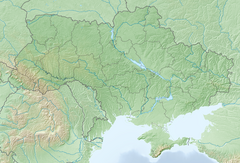Stokhid
This article may be a rough translation from Ukrainian. It may have been generated, in whole or in part, by a computer or by a translator without dual proficiency. (May 2019) |
| Stokhid River | |
|---|---|
 | |
| Physical characteristics | |
| Source | |
| • coordinates | 50°48′27″N 24°51′57″E / 50.8075°N 24.8657°E |
| Mouth | Pripyat River |
• coordinates | 51°51′27″N 25°38′03″E / 51.85750°N 25.63417°E |
| Length | 188 km (117 mi) |
| Basin size | 3,150 km2 (1,220 sq mi) |
| Basin features | |
| Progression | Pripyat→ Dnieper→ Dnieper–Bug estuary→ Black Sea |
The Stokhid (Template:Lang-uk) is a river in Volyn Oblast, Ukraine. It is a right tributary of the Pripyat River. It is 188 kilometres (117 mi) long, and has a drainage basin of 3,150 square kilometres (1,220 sq mi).[1]
Description
Stokhid is the longest and cleanest river in Volyn. The valley in the upper reaches is clearly delineated, up to 4-4.5 km wide, below - indistinct, up to 7-10 km wide. The floodplain is two-sided, swampy, wide from 0,4 km (in the upper reaches) to 2,5 km (in the lower reaches). The heights can be traced mainly to the upper reaches, where the width is 20-25 m, and the depth is 0.5-1.5 m. The river (especially below the village Zayachivka) is divided into numerous sleeves (hence the name - "stoop") in the width of 5- 15 m (at most - 60 m), depth up to 8-26 m (on plyas). The largest depth is 16.4 m, which is located between Lyubeshiv and the village. Zinov, the depth formed by the sources that feed the river; there are many elders. The largest settlement near the river is the city of Lyubeshiv. On a length of 50 km the river is deepened and straightened. Power mixed with the advantage of snow; freezes in December, crashes in March. The mineralization of the water of the river Stokhid is on average: spring flood - 440 mg / dm³; summer-autumn measurements - 465 mg / dm³; winter limits - 559 mg / dm³. [2]
Location
Stokhid originates near the village Semerinskoe, Volyn Polissya, within the Volyn Highlands. Flows mainly to the northeast. Falls into the Pripyat near the southern outskirts of the village Svalovichy. Tributaries: Stobihivka, Yasinovka, Loknitsa (left); Aspen, Cheryah, Hryvka, Chervysh (right). Above the river is the district center of Lubeshivand many villages of Lokachinsky, Turiyskoye, Rozhyshchensky, Kovelsky, Manevytsky, Kamen-Kashirsky and Lyubeshivsky districts.
Interesting Facts
Above the Stokhid was the front line from June 1916 to August 1917 between the Austro-Hungarian-German and Russian troops.
In the First World War, after the Brusilov breakthrough (the main hostilities took place within the Volyn region), along the river Stokhid and Pripyat there was a defensive line lasting almost a year between the Russian and Austro-German troops. On the left bank the latter created trenches and concrete ditches, serviced by a network of narrow-gauge railways for the transport of ammunition. On the right bank were Russian troops, whose defensive works were wooden and of which nothing has therefore survived.
In the years of the First World War, there were several changes to the front line on the Volhynia between the Russians and the Austro-German troops. In June 1916, Russian troops under the command of General Brusilov broke through the front, took Lutsk and pushed the Austro-German troops to the Stokhid River line. For more than a year, the front adhered to this line, resulting in the destruction of many nearby settlements. During the Brusilov breakthrough about 1 million Austro-Germans and 500,000 Russian troops died. All the surrounding villages around Stokhid were completely destroyed. Russian troops tried to break through Stokhid again, but in vain.
The swampy valleys and banks of the Stokhid River became the grave of thousands of soldiers and officers of the Russian Imperial Guard and the Austro-Hungarian and German forces. This operation is called historians by the "Stokhidsky" meat grinder. Oral evidence from local inhabitants indicates that in the late 1920s men came from Germany to rebury their compatriots in a cemetery in the village of Polyana, two kilometres from the Loviš.
The river flows through the National Nature Park "Pripyat-Stokhid".
References
- ^ Стоход, Great Soviet Encyclopedia
- ^ Geographical Encyclopedia of Ukraine: 3 t. / Editorial Board: O. M. Marinych (repl. Ed.) And others. - K.: "Ukrainian Soviet Encyclopedia" by them. M.P. Bazhana, 1989.
- Encyclopedia of Ukrainian Studies: Dictionary part: [in 11 volumes] / Scientific society named after Shevchenko; Goal. Ed. Prof. Dr. Volodymyr Kubiyovych. - Paris; New York: Young Life; Lviv; Kyiv: Globus, 1955–2003.
- Peter Kravchuk "The book of records of Volyn", Lyubeshiv. 2005 ISBN 966-361-079-4.
- Peter Kravchuk Conflict around the dam


